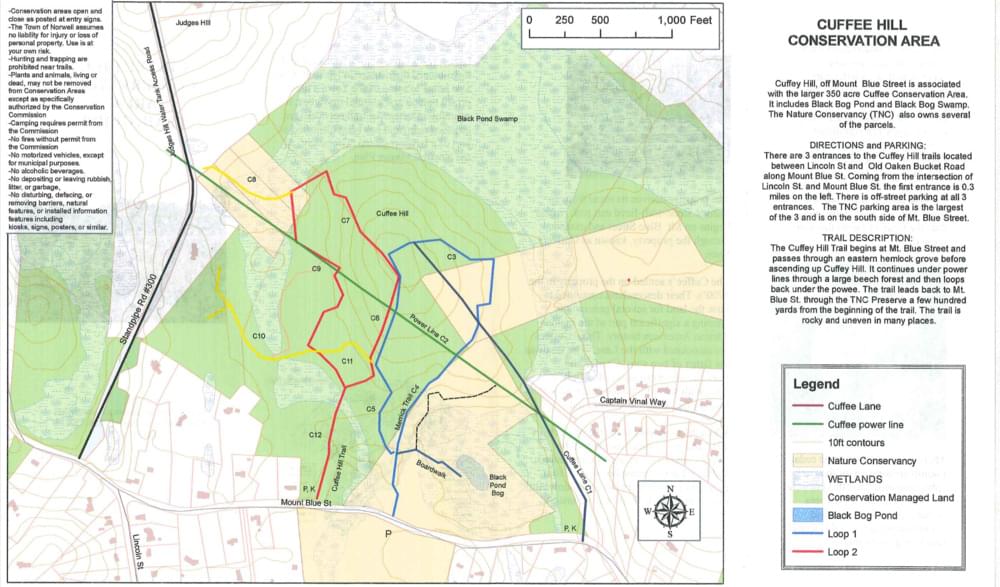Black Pond Bog and Cuffee Hill Conservation Area, Norwell
Black Pond Bog and Cuffee Hill Conservation Area, Norwell
Norwell, Massachusetts 02061
Cuffee Hill Conservation Area (North and South Rivers Watershed Association) webpageCuffee Hill Conservation Area trail guide and map
About this Location
Cuffee Hill Conservation Area is 350 acres of Norwell Conservation land including Black Pond Bog and Black Pond Swamp. Also known as Cuffey Hill. Portions are owned by The Nature Conservancy.
Most of the Cuffee Hill Conservation Area is owned by the Town of Norwell, but portions of it belong to the Nature Conservancy. The 83-acre Black Pond Bog Nature Preserve is one of only nine Nature Conservancy properties in Massachusetts. In 1962, it became the first of such properties in our state, thanks to a collaborative effort by local garden clubs, the Massachusetts Audubon Society, the North River chapter of the Izaak Walton League, and the Nature Conservancy.
Black Pond itself is a kettlehole pond, created tens of thousands of years ago by a large chunk of melting glaciers. William “Cap’n Bill” Vinal, an Emeritus Professor of Nature Education at the University of Massachusetts, published a booklet in the 1960s, entitled “A Visit to Black Pond Reservation.” In it, he explained how as the white cedar trees and other vegetation that grew around Black Pond died and decayed, they sank to the bottom, creating a layer of muck. Over time, the water became so acidic that the surrounding plants could barely make use of it. What resulted was a quaking bog.
Black Pond is surrounded by sphagnum moss. One of few plants capable of growing in such acidic conditions, sphagnum absorbs water from the air, not from the pond. As it dies and decays, it forms a layer of peat. Other plants take root in the moss and peat, creating a thick mat at the edge of the water. When you step onto a quaking bog, you can feel it shake!
Cuffee Hill is known for its historic features as well as its natural ones. The property is named for Cuffee Lane, a historic cart path lined with stone walls that begins on Mount Blue Street and extends through the property. In the 1700s, Cuff Grandison and his wife established a farm on the property, clearing two fields and moving the rocks to the sides to build stone walls. The Grandisons were among the town’s earliest African American settlers. Their descendants, including Simeon and Charles Grandison, continued to farm the land for several generations. Members of the Grandison family served with the Green Mountain Boys in the American Revolution. The land eventually fell out of agricultural use, and the forest has since begun to regenerate. This video delves deeper into the history of Cuffee Lane and the Grandison family.
Before the Grandisons, the land was owned by Thomas Clapp and his descendants. In 1640, Clapp received a grant of 75 acres at Black Pond from Plymouth Colony. By 1707, he had acquired additional acreage, mostly swampland, in six separate transactions. Joseph Clapp is remembered for sheltering 40 Acadians who were deported from Nova Scotia during the French and Indian War.
The town of Norwell purchased most of the lands in the Cuffee Hill Conservation Area in 2013, creating the largest contiguous area of protected, town-owned open space in the town. Black Pond Brook flows through the property, eventually joining Second Herring Brook, which flows into the North River.
There is a power line easement, marked in green, through the property that intersects with all of the trails outlined above.
Notable Trails
The Cuffee Hill Trail, marked in red, begins at Mount Blue Street and passes through an eastern hemlock grove before ascending to Cuffee Hill. It continues under power lines through a large beech forest and then loops back. The trail leads back to Mount Blue Street through property owned by The Nature Conservancy. The trail is rocky and uneven in many places. There are at least two spur trails off the main trail, marked in yellow, that extend toward the boundaries of the property.
Adjacent to The Cuffee Hill Trail, farther down Mount Blue Street, is the Merrick Trail, marked in blue, which is also a loop. The two trails come together briefly on Cuffee Hill. A boardwalk spur extends from the Merrick Trail into Black Pond Bog.
A third trail leads from another location on Mount Blue Street, along the border of Black Pond Bog, and eventually intersects with the Merrick Trail.
The AllTrails website has a description and map of a hike at Cuffee Hill Conservation Area.
Features
Restrooms on site
Wheelchair accessible trail
Entrance fee
Content from Cuffee Hill Conservation Area (North and South Rivers Watershed Association) webpage
Last updated February 19, 2024
